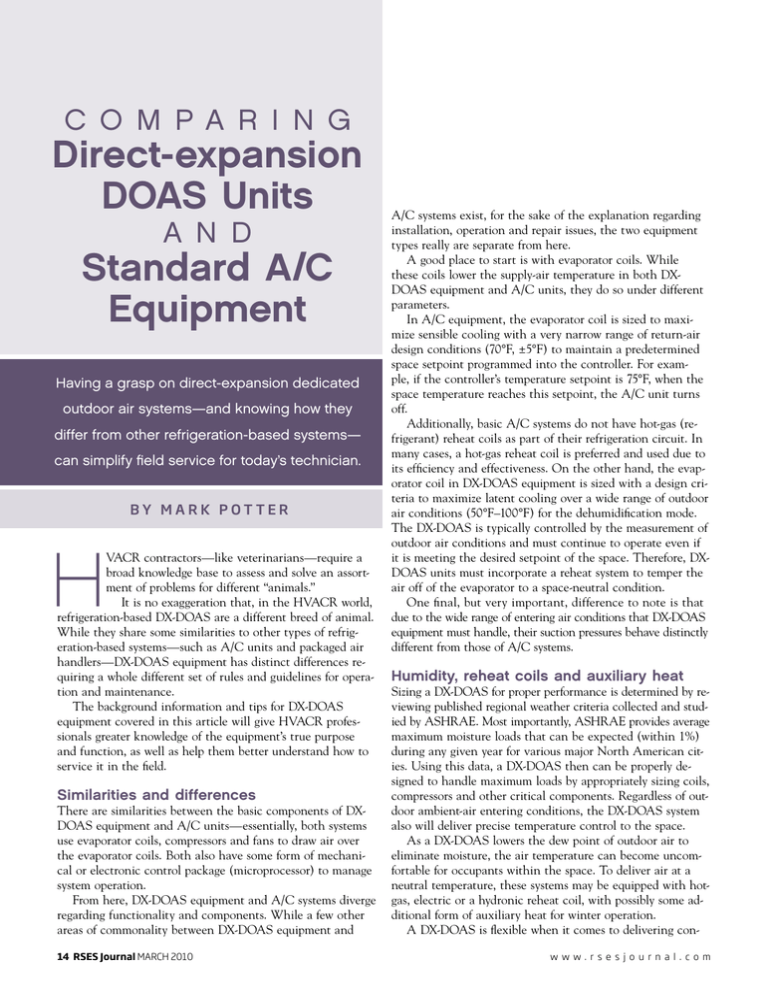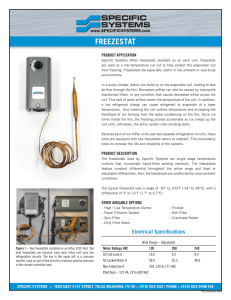Direct-expansion DOAS Units Standard A/C Equipment
advertisement

C o m pa r i n g Direct-expansion DOAS Units a n d Standard A/C Equipment Having a grasp on direct-expansion dedicated outdoor air systems—and knowing how they differ from other refrigeration-based systems— can simplify field service for today’s technician. By Mark Potter H VACR contractors—like veterinarians—require a broad knowledge base to assess and solve an assortment of problems for different “animals.” It is no exaggeration that, in the HVACR world, refrigeration-based DX-DOAS are a different breed of animal. While they share some similarities to other types of refrigeration-based systems—such as A/C units and packaged air handlers—DX-DOAS equipment has distinct differences requiring a whole different set of rules and guidelines for operation and maintenance. The background information and tips for DX-DOAS equipment covered in this article will give HVACR professionals greater knowledge of the equipment’s true purpose and function, as well as help them better understand how to service it in the field. Similarities and differences There are similarities between the basic components of DXDOAS equipment and A/C units—essentially, both systems use evaporator coils, compressors and fans to draw air over the evaporator coils. Both also have some form of mechanical or electronic control package (microprocessor) to manage system operation. From here, DX-DOAS equipment and A/C systems diverge regarding functionality and components. While a few other areas of commonality between DX-DOAS equipment and 14 RSES Journal MARCH 2010 A/C systems exist, for the sake of the explanation regarding installation, operation and repair issues, the two equipment types really are separate from here. A good place to start is with evaporator coils. While these coils lower the supply-air temperature in both DXDOAS equipment and A/C units, they do so under different parameters. In A/C equipment, the evaporator coil is sized to maximize sensible cooling with a very narrow range of return-air design conditions (70°F, ±5°F) to maintain a predetermined space setpoint programmed into the controller. For example, if the controller’s temperature setpoint is 75°F, when the space temperature reaches this setpoint, the A/C unit turns off. Additionally, basic A/C systems do not have hot-gas (refrigerant) reheat coils as part of their refrigeration circuit. In many cases, a hot-gas reheat coil is preferred and used due to its efficiency and effectiveness. On the other hand, the evaporator coil in DX-DOAS equipment is sized with a design criteria to maximize latent cooling over a wide range of outdoor air conditions (50°F–100°F) for the dehumidification mode. The DX-DOAS is typically controlled by the measurement of outdoor air conditions and must continue to operate even if it is meeting the desired setpoint of the space. Therefore, DXDOAS units must incorporate a reheat system to temper the air off of the evaporator to a space-neutral condition. One final, but very important, difference to note is that due to the wide range of entering air conditions that DX-DOAS equipment must handle, their suction pressures behave distinctly different from those of A/C systems. Humidity, reheat coils and auxiliary heat Sizing a DX-DOAS for proper performance is determined by reviewing published regional weather criteria collected and studied by ASHRAE. Most importantly, ASHRAE provides average maximum moisture loads that can be expected (within 1%) during any given year for various major North American cities. Using this data, a DX-DOAS then can be properly designed to handle maximum loads by appropriately sizing coils, compressors and other critical components. Regardless of outdoor ambient-air entering conditions, the DX-DOAS system also will deliver precise temperature control to the space. As a DX-DOAS lowers the dew point of outdoor air to eliminate moisture, the air temperature can become uncomfortable for occupants within the space. To deliver air at a neutral temperature, these systems may be equipped with hotgas, electric or a hydronic reheat coil, with possibly some additional form of auxiliary heat for winter operation. A DX-DOAS is flexible when it comes to delivering conw w w. r s e s j o u r n a l . co m Image courtesy of Desert Aire Corp. ditioned outdoor air. It can supply the air directly to an occupied or unoccupied space. It also can supply pretreated air to other sensible conditioning equipment—for example, an air handler via plenums. Air flow Another important factor that influences the sizing and operation of DOAS equipment is air flow measured in cfm. ASHRAE standards dictate the necessary air volume for a space, which in turn affects the size of the DX-DOAS for the application. There also is a relationship between the air flow and the size of the evaporator coil used. In general, the higher the cfm required, the larger the evaporator coil that is needed; in principal, when highly saturated outdoor air is rushing over the evaporator coil at a high rate of cfm, the capacity of the evaporator coil must be increased to effectively remove moisture before supplying the air to the space. Of course, this depends on the design-day conditions as established by existing ASHRAE data for a particular location. Conversely, if the required cfm is lower, a smaller coil may be sufficient in order to adequately remove moisture. Essentially, the outdoor air is spending more time flowing over the coil—allowing it more time to drop its temperature and release its moisture. But again, matching the DX-DOAS coil size to the desired cfm depends on the design-day parameters of a given location as established by existing ASHRAE data. Remember, DX-DOAS units are sized for these design conditions and the controls will unload the compressors at part load conditions. Even when a DX-DOAS is appropriately sized for an application, the air flow must be balanced in the field so the system performs at maximum efficiency. When units are sized, cfm requirements are given with a specific duct-pressure value—referred to as external static pressure. This is usually reviewed and balanced during startup by adjusting the blower motor’s pulleys and/or sheaves. w w w. r s e s j o u r n a l . co m Because DX-DOAS equipment (shown here in a rooftop installation) is generally controlled by the measurement of outdoor air conditions—and continues to operate even if it meets the desired setpoint— these units must have a reheat system that tempers air off the evaporator to space-neutral condition. Several problems can develop as a result of incorrect air flow through the DX-DOAS. Other than providing proper code ventilation, there are basically two air-flow situations that can occur: lack of air flow and excessive air flow. Lack of air flow—Insufficient air flow is actually the most common reason for poor system performance. Low Circle Reader Service No. 28 MARCH 2010 RSES Journal 15 HVARC techs can perform a Magnehelic reading to determine proper cfm by reading static pressure drops across the evaporator coil (shown in the open unit at lower right). “ Even when a DX-DOAS is appropriately sized for an application, the air flow must be balanced in the field so the system performs at maximum efficiency. ” Images courtesy of Desert Aire Corp. air flow can contribute to improper building pressurization. Buildings are usually designed to be pressurized with conditioned outdoor air, which prevents moisture from migrating into the building—whether it comes from the opening of exterior doors or permeating through the skin of the structure. Additionally, inadequate air flow can inhibit the efficiency and performance of the evaporator coil by causing reduced suction pressure and a decrease in moisture removal. Low suction pressure also will trigger hot-gas bypass operation. The hot-gas bypass valve activates when the suction temperature falls below 32°F. When this valve is active, suction pressure will rise and create a false load on the evaporator coil, thus contributing to poor moisture removal. Excessive air flow—Likewise, excessive air flow also creates improper building pressurization. Too much outdoor air can prevent exterior doors from closing—consequently wasting energy as the DX-DOAS introduces more treated outdoor air to the facility than is necessary. With excessive air flow, the evaporator coil also will absorb too much energy. This in turn will cause elevated suction pressures, meaning the evaporator coil will be balanced at higher temperatures. In other words, the evaporator coil will lack sufficient latent-cooling capacity, which in turn contributes to a lack of moisture removal or a higher saturated suction temperature. This will prevent the DX-DOAS from achieving the design dew point. 16 RSES Journal MARCH 2010 During startup, balancing air flow is normally the first priority. Although it is ideal to have independent TAB technicians available, it is not always feasible. When this is the case, HVACR technicians can determine proper cfm by measuring static pressure drops across the evaporator coil. Technicians may use either a Magnehelic or inclined manometer to measure coil pressure differentials. The cfm will vary depending on the system’s design parameters; however design values for any given DX-DOAS can be found with the system’s startup documentation. Remember, static measurements should be used as a guideline and are usually accurate within 10%. The TAB contractor will always need to make final adjustments. Taming DOAS Five basic criteria must be met to ensure the proper design and function of DX-DOAS equipment for specific applications: 1. Determine the necessary volume of air (cfm); 2. Know the maximum design conditions (db/wb per ASHRAE 1% design data); 3. Deliver the desired required dew point; 4. Deliver the desired leaving air temperature; and 5. Recognize that suction temperatures are a function of the entering air conditions. HVACR service professionals who understand these factors that guide the operation of DX-DOAS units will be better equipped to service this type of equipment now and in the future. Mark Potter is the Service Manager of Desert Aire Corp., and has worked for more than 20 years in various capacities, including building, testing, starting and troubleshooting equipment from all product lines. For the past 14 years, he has managed the service department, coordinating equipment startups, answering questions from the field and resolving product issues. For more information, e-mail mpotter@desert-aire.com. w w w. r s e s j o u r n a l . co m


